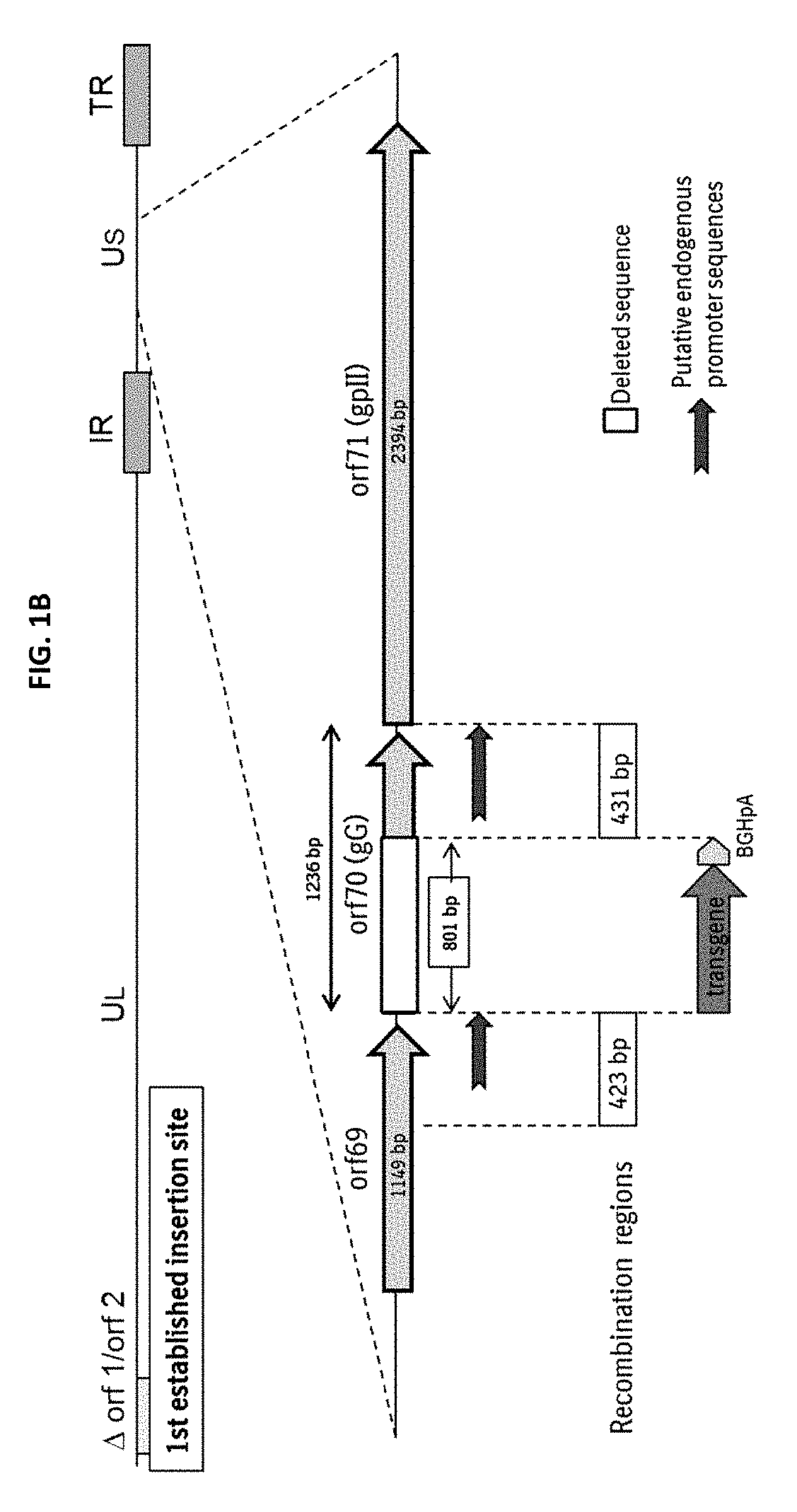New swine influenza vaccine
a technology of swine flu and vaccine, applied in the field of new swine flu vaccine, can solve the problems of not being the first choice of promoter for transgenic vector vaccine in general, theoretical risk cannot be excluded, and the amount of transgenic protein expressed without an additional exogenic promoter is usually relatively low, so as to achieve similar efficiency, reduce the cost of goods significantly, and high
- Summary
- Abstract
- Description
- Claims
- Application Information
AI Technical Summary
Benefits of technology
Problems solved by technology
Method used
Image
Examples
example 1
Establishment of the New Insertion Site ORF70
[0501]In order to augment the capabilities of the EHV-1 vector the inventors sought to find a way to express two different transgenes from one vector backbone without coupling two transgenes by RNA-virus-derived functions under control of one promoter. The inventors hypothesized that the herpesvirus genome would tolerate the use of two independent transgene insertion sites in parallel. To determine whether the EHV-1 ORF70 was a suitable transgene insertion site, 801 basepairs of the 5′ end of orf70 (1236 bp) were replaced with an expression cassette coding for the autofluorescent mCherry protein (Shaner et al. 2004) by classical homologous recombination (FIG. 1B). A map of the plasmid pU-mC70-BGH is in FIG. 2 (SEQUENCE ID NO. 21). The DNA fragment used for homologous recombination was excised from pU-mC70-BGH with XbaI. The gel-purified fragment was co-transfected with viral genomic DNA of EHV-1 RacH into RK13 cells. Efficient rescue of r...
example 2
Identification and Construction of New Promoters
[0502]The strategy to identify suitable promoter sequences was as follows: 600 bp fragments of the EHV-4 sequence upstream of two known orfs were analyzed first by aligning them with the respective sequence fragments of the EHV-1 genome. The genes chosen were orf42 encoding the major capsid protein (MCP), and orf70 encoding glycoprotein G (gG). The major capsid protein is one of the most abundant constituents of the virion and needed for assembly of capsids in the cell nucleus as soon as newly synthesized viral DNA is ready for packaging. Its promoter is therefore expected to be active during early and late times in the viral replication cycle. For glycoprotein G it is known that its gene (orf70) is active also during early and late times in the replication cycle (Colle et al. 1995, Drummer et al. 1998). Sequence identity was 82.2% for the putative MCP-promoter and 82.3% for the putative gG-promoter. These differences were considered l...
example 3
Use of the New p455 Promoter in Recombinant EHV-1 Vector Vaccines and Construction of a Recombinant Virus
[0516]The p455 Promoter:
[0517]For a first animal experiment an Influenza hemagglutinin subtype H3 from a swine origin Influenza A virus (A / swine / Italy / 7680 / 2001(H3N2), GenBank accession no.: ABS50302.2), SEQ ID NO:27 was used. Its coding sequence was synthesized and subcloned into transfer vector pU70-p455-71K71 (FIG. 5) generating the transfer vector pU70-p455-H3-71K71, placing H3 under control of the new p455 promoter and the new 71 pA polyadenylation signal and framing the cassette with the recombination regions for insertion into orf70 (FIG. 6).
[0518]By en passant mutagenesis using the RED recombination system (Tischer et al. 2006) the expression cassette p455-H3-71 was inserted in orf70 of pRacH-SE to generate pRacH-SE70-p455-H3 (FIG. 7).
[0519]PK / WRL cells were transfected with pRacH-SE70-p455-H3, recombinant virus rEHV-1 RacH-SE70-p455-H3 was rescued and plaque-purified twi...
PUM
| Property | Measurement | Unit |
|---|---|---|
| Fraction | aaaaa | aaaaa |
| Fraction | aaaaa | aaaaa |
| Fraction | aaaaa | aaaaa |
Abstract
Description
Claims
Application Information
 Login to View More
Login to View More - R&D
- Intellectual Property
- Life Sciences
- Materials
- Tech Scout
- Unparalleled Data Quality
- Higher Quality Content
- 60% Fewer Hallucinations
Browse by: Latest US Patents, China's latest patents, Technical Efficacy Thesaurus, Application Domain, Technology Topic, Popular Technical Reports.
© 2025 PatSnap. All rights reserved.Legal|Privacy policy|Modern Slavery Act Transparency Statement|Sitemap|About US| Contact US: help@patsnap.com



